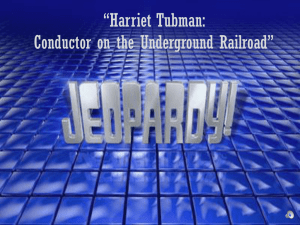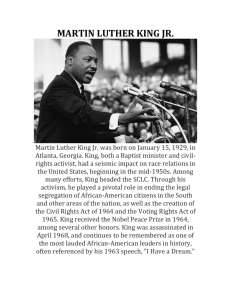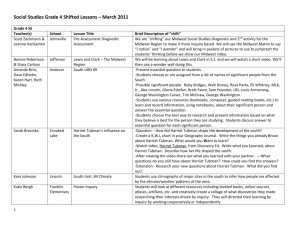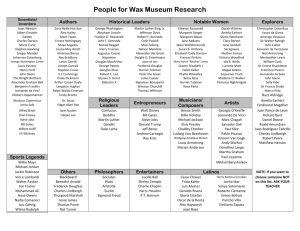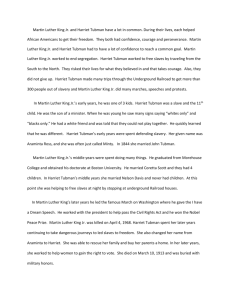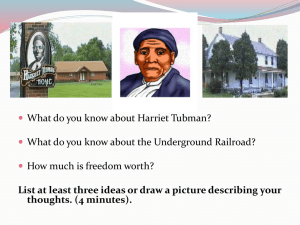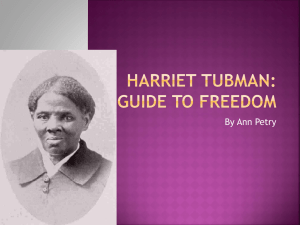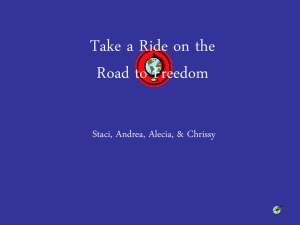Harriet Tubman - Achieve the Core
advertisement
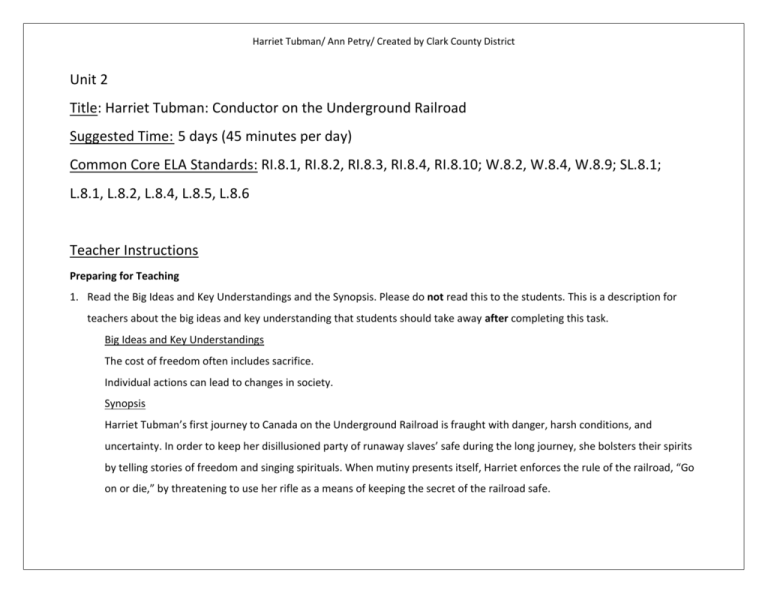
Harriet Tubman/ Ann Petry/ Created by Clark County District Unit 2 Title: Harriet Tubman: Conductor on the Underground Railroad Suggested Time: 5 days (45 minutes per day) Common Core ELA Standards: RI.8.1, RI.8.2, RI.8.3, RI.8.4, RI.8.10; W.8.2, W.8.4, W.8.9; SL.8.1; L.8.1, L.8.2, L.8.4, L.8.5, L.8.6 Teacher Instructions Preparing for Teaching 1. Read the Big Ideas and Key Understandings and the Synopsis. Please do not read this to the students. This is a description for teachers about the big ideas and key understanding that students should take away after completing this task. Big Ideas and Key Understandings The cost of freedom often includes sacrifice. Individual actions can lead to changes in society. Synopsis Harriet Tubman’s first journey to Canada on the Underground Railroad is fraught with danger, harsh conditions, and uncertainty. In order to keep her disillusioned party of runaway slaves’ safe during the long journey, she bolsters their spirits by telling stories of freedom and singing spirituals. When mutiny presents itself, Harriet enforces the rule of the railroad, “Go on or die,” by threatening to use her rifle as a means of keeping the secret of the railroad safe. Harriet Tubman/ Ann Petry/ Created by Clark County District 2. Read the entire selection, keeping in mind the Big Ideas and Key Understandings. 3. Re-read the text while noting the stopping points for the Text Dependent Questions and teaching Tier II/academic vocabulary. During Teaching 1. Students read the entire selection independently. 2. Teacher reads the text aloud while students follow along or students take turns reading aloud to each other. Depending on the text length and student need, the teacher may choose to read the full text or a passage aloud. For a particularly complex text, the teacher may choose to reverse the order of steps 1 and 2. 3. Students and teacher re-read the text while stopping to respond to and discuss the questions, continually returning to the text. A variety of methods can be used to structure the reading and discussion (i.e., whole class discussion, think-pair-share, independent written response, group work, etc.) During Teaching (Differentiation-Struggling Readers) 1. Teacher reads the first section of the text aloud (page 499 to bottom of the first column on page 500). Students reread the section, stopping to respond to and discuss the questions, continually returning to the text. 2. Students read the second column of page 500 to the header on page 504 independently or in partners/groups. Students reread the section, stopping to respond to and discuss the questions, continually returning to the text. 3. Students read from the header on page 504 to the end of the selection independently or in partners/groups. Students reread the section, stopping to respond to and discuss the questions, continually returning to the text. 4. Additional option is for the teacher to read the text aloud while students follow along or students take turns reading aloud to each other. Depending on the text length and student need, the teacher may choose to read the full text or a passage aloud. Harriet Tubman/ Ann Petry/ Created by Clark County District 5. Students and teacher re-read the text while stopping to respond to and discuss the questions, continually returning to the text. A variety of methods can be used to structure the reading and discussion (i.e., whole class discussion, think-pair-share, independent written response, group work, etc.) Text Dependent Questions Text-dependent Questions Reread page 500. What actions did Harriet Tubman take to prepare for the journey? Cite evidence from the text to support your answer. Evidence-based Answers She used a whippoorwill call as a signal, waited for a clear night when the North Star was visible, carefully selected the slaves to take, and announced her arrival by singing the forbidden spiritual. She also asked them to pack ashcake in a bundle. What words or phrases does the author use to reveal the tone on page 500? Describe the tone at this point in the text. Answers will vary but may include hastily, machinery of pursuit, murmur borne on the wind, and spread ear to mouth. Harriet feels the size of the group is a new danger, especially since they are going all the way to Canada. These examples convey the tone of urgency evident within the text. The text stated, “the men who made a living hunting for runaway slaves were out of reach…” This sentence illustrates that the machinery of pursuit is the hunt for the runaway slaves by the owners. Leaving on Sunday meant that the owners would be off hunting or in church and the businesses were closed, so nothing could be printed to help with the hunt for the slaves. According to the text, “the men who made a living hunting for runaway slaves were out of reach…” “The posters offering rewards for the fugitives could not be printed until Monday.” The Fugitive Slave Law was more severe. Slaves now had to go to Canada to be free, (pg. 501 note 4) and it was a crime to help In paragraph 2 on page 500, what is the “machinery of pursuit” that the author refers to? Use evidence from the text that helped you identify this meaning. How did leaving on Sunday impact the effectiveness of the “machinery of pursuit” and the journey? Use evidence from the text to explain your answer. (Pg. 500) How did The Fugitive Slave Law impact Harriet’s decisions regarding the 1851 journey? (Pg. 501) Harriet Tubman/ Ann Petry/ Created by Clark County District Reread column two on page 502. What do Harriet’s actions reveal about her ability to lead? Cite textual evidence from the text to support your answer. What was the potential impact of one fugitive returning to the plantation? What was explicitly stated in the text that helped you understand this impact? (Pgs. 506–507) Harriet Tubman says, “We got to go free or die. And freedom’s not bought with dust.” (Pgs. 506–507) How does the quote relate to the significance of the journey? Harriet Tubman says, “We got to go free or die. And freedom’s not bought with dust.” (Pgs. 506–507) How does this quote, create a shift in the tone of the text? aid escaped slaves. For these reasons, Harriet had to change her plans to include a journey all the way to Canada, a trip she had not previously made. Harriet had the ability to use various leadership tactics to make the trip to Canada safe for her and the other fugitives. According to the text, Harriet had to instill courage in the fugitives by telling them of hope and freedom, rather than the hardships of the journey (pg. 502). She had to encourage them, as well as keep the “fear of pursuit” in them so they would stay awake and keep moving (pg. 502). The potential impact was that, “the master and the overseer would force him to turn traitor.” (pg. 506) Additionally, “The return of the slave would disclose the stopping places…” (pg. 506), risking the safety and security of those who were involved in the Underground Railroad which could lead to potential criminal charges and the shutdown of the railroad itself. (pg. 506) This quote is used by Tubman to set the tone for what she knew would be a perilous journey with challenges all along the way. The reader sees this quote for the first time when Harriet makes it clear to the slaves she is willing to use her gun if needed, to deter a fugitive who wants to turn back. “Go on with us or die.” (pg. 506) In this, the reader understands that the whole (the Underground Railroad system) is more significant than its parts. She further illustrates the true meaning of this quote with stories of agony, torture, and even death that are the institution of slavery. (pg. 507) Directly following the quote (pg. 506) the tone shifts from that of being grim and forthright (following the mutiny attempt) to that of being reflective and reverent about the past injustices that were endured, such as those on the Middle Passage. “…on Harriet Tubman/ Ann Petry/ Created by Clark County District How do each of the following stories told strategically throughout the journey represent the sacrifices made in the name of freedom? Harriet’s story: page 501, 3rd paragraph Thomas Garrett’s story: page 503, entire page William and Ellen Craft’s and Fredrick Douglass stories: page 504, last paragraph & page 505, 1st column Middle Passage and Thomas Sims stories: page 507, 1st column the old slave ships, about the black horror of the holds, about the chains and the whips.” (pg. 507) Harriet begins to build the spirit of the slaves right away by telling them stories of her own first flight. (pg. 501) Because she has the knowledge of what it is like to be and feel free, she was soliciting their trust and loyalty to the group. This journey is particularly dangerous, because of the large number of slaves (pg. 501), so Harriet uses vivid descriptions to keep everyone motivated and focused on the journey, including herself. Harriet tells the story of Thomas Garrett, a Quaker who not only provided shelter and food to fugitives, but gave them shoes from his store as well. His story is significant at this time in the journey because the fugitives have just faced great disappointment by being denied entry to the first safe house on their journey. Harriet continually instills hope with the promise that other safe houses will be open to them for the much needed rest and food. “Once they reached his house in Wilmington they would be safe.” (pg. 503) The William and Ellen Craft story tells of a runaway couple who successfully reached freedom. They devised a plan for escape which included passing for a white planter (Ellen disguised as a man) and his slave. They used the pretense of a crippling illness to avoid signing the hotel registers. When this story has little effect, Harriet tells them of Fredrick Douglass, who also managed to gain his freedom. These stories are intended to provide the fugitives with additional “hope” by clinging to the fact that many before them have been successful in their runaway attempt and are now experiencing freedom and all the privileges it has to offer. Harriet, at this time, suspects they Harriet Tubman/ Ann Petry/ Created by Clark County District are too filled with despair to move on, “they had been tired too long…” (pg. 505) Who was William Still and how does including an excerpt from his book (from the forward) support the main ideas presented in the text? (Pg. 504–505, 508) Religion plays a role in the lives of those willing to be a part of the Underground Railroad system. Cite textual evidence to support this statement. (Pg. 508) The story of the Middle Passage and the story of Thomas Sims both reflect the horror of being held in captivity. The Middle Passage is the transport from Africa to the United States on the slave ships. Thomas Sims was an escaped slave who was captured and nearly beaten to death as a result of his runaway attempt. Harriet has to reinforce the brutality of slavery in order to keep her group moving toward Canada, especially after a mutinous attempt by a slave in her party. William Still, a free African American, was an active member of the Underground Railroad who not only supplied money to Harriet Tubman, but recorded the names and important information about runaway slaves. He later published a book based on these records. He was also chairman of the Philadelphia Vigilance Committee. (pg. 504) The author includes this information to show the danger ordinary people were willing to face in the name of freedom. He considered any sacrifice well worth it “it used to afford me great satisfaction to take them down…” (pg. 508) This section also provides the reader with historical authenticity. When referring to Harriet’s religious connection, answers could include the “Moses” reference, singing of a forbidden spiritual, “camp meetings saying their prayers,” and “freedom’s not bought with dust.” Other individuals were also using their religion as inspiration to help those in need, including Thomas Garrett whose Quaker religion promoted a movement to end slavery, and the Reverend J.W. Loguen who helped Harriet in Syracuse. (pg. 508) Harriet Tubman/ Ann Petry/ Created by Clark County District Based on key events in the text, determine the central idea of “Harriet Tubman: Conductor on the Underground Railroad.” Support your central idea statement with textual evidence. The central idea could be based on sacrifice, freedom, society, survival, change, courage, etc., all ideas that are reflected in the text. An example is “The cost of freedom is sacrifice.” Support for this statement could include details referencing any of the individuals who are mentioned in the text as aiding the fugitives, all of whom willingly faced great danger. Also, the events that occur on the 1851 journey would provide evidence. Examples include the willingness of Harriet to use force if necessary during the attempt by a slave to turn back (pg. 506) and the story of William Still’s records. “Then he carefully hid what he had written, for fear it might be discovered. (pg. 507) Harriet Tubman/ Ann Petry/ Created by Clark County District Meaning needs to be provided Meaning can be learned from context Tier II/Academic Vocabulary These words require less time to learn These words require more time to learn (They are concrete or describe an object/event/ process/characteristic that is familiar to students) (They are abstract, have multiple meanings, are a part of a word family, or are likely to appear again in future texts) Page 500 – fugitives Page 500 – vicinity Page 502 – instill Page 505 – vain Page 506 – disclose Page 507 – implicitly Page 507 – agony Page 502 – unconcealed astonishment Page 504 – sullen Page 504 – measure of contentment Page 505 – eloquence Page 505 – register Page 507 – liable Page 508 – fastidious Page 508 – blotted Page 499 – vaguely Page 501 – pursuit Page 501 – pursued Page 502 – disheveled Page 502 – dispel Page 504 – guttural Page 507 – seized Page 507 – indomitable Pages 500 & 507 – hastily Page 501 – incomprehensible Page 504 – serenity Page 504 – mutinous Page 505 – evoking Page 507 – cajoling Harriet Tubman/ Ann Petry/ Created by Clark County District Culminating Writing Task Prompt o “Harriet Tubman: Conductor on the Underground Railroad” is an excerpt from the biography written by Ann Petry. Throughout the journey, Tubman often said, “We got to go free or die. And freedom’s not bought with dust.” In an essay, explain how the actions of Harriet Tubman and at least two other individuals from the text relate to the themes of freedom and sacrifice as illustrated by this quote. Teacher Instructions 1. Students identify their writing task from the prompt provided. 2. Students complete an evidence chart as a pre-writing activity. Teachers should guide students in gathering and using any relevant notes they compiled while reading and answering the text-dependent questions earlier. Some students will need a good deal of help gathering this evidence, especially when this process is new and/or the text is challenging! Evidence Quote or paraphrase “There was a hidden room in the store. A whole wall swung open, and behind it was a room where he could hide fugitives.” “He was a friend of all fugitives. He called them God’s poor.” “He was a big man and strong, but he had never Page number 503 503 entire page Elaboration / explanation of how this evidence supports ideas or argument Hiding fugitives was and is against the law. However, with the passage of the 1850 Fugitive Slave Law, the penalties were even harsher. Garrett was risking his own safety and all he owned to help fugitives. Safety is much more than “dust.” Thomas Garrett, a Quaker, provided shelter to all fugitives and gave them shoes from his store as well. Thomas believed it was his duty to help the fugitives despite the risk to his own safety. Unlike Harriet Tubman/ Ann Petry/ Created by Clark County District used his strength to harm anyone, always to help people.” “Ellen was so fair that she looked as though she were white, and so she dressed up in a man’s clothing and she looked like a wealthy young planter.” Her husband, William, who was dark, played the role of her slave. 505 “Ellen pretended to be very ill—her right arm was in a sling and her right hand was bandaged because she was supposed to have rheumatism. Thus, she avoided having to sign the register at hotels, for she could not read or write. “ 505 “She told them about Thomas Sims, the boy picked up on the streets of Boston and sent back to Georgia. She said when they got him back to Savannah, got him in prison there, they whipped him until a doctor who was standing by watching said, “You’ll kill him is you strike him again!” His master said, “Let him die.” 507 “These people who had risked their own security 506 the slave owners of the South, Thomas used his size and strength to help the fugitives rather than what the fugitives were used to by the men on the plantation. Ellen could have easily escaped to the North on her own, being that she looked white; yet, she risked her own safety and possible freedom to chance freedom for her husband, also. Ellen not only believe “We got to go free or die” for herself, but she was willing to die for another’s freedom. Ellen and William sacrificed their personal integrity by having to live a lie on the long journey. Every word they spoke or action they performed could give them away. Pretending to be ill and bandaging her arm so she could hide the fact that she was illiterate, illustrates the detail in which they had to plan every move they made in order to keep up the façade. Although we do not know the ultimate fate of Thomas Sims, this quote speaks to the true risk of death in a failed attempt at freedom. Even the attempt at freedom earned Thomas a life threatening whipping. Thomas must have known his master did not value his life at all and that if Thomas was ever delivered back into the hands of his master, it probably meant his life. The stories told by Harriet Tubman represent the Harriet Tubman/ Ann Petry/ Created by Clark County District to help runaways would be ruined, fined, imprisoned.” “She had never been in Canada, but she kept painting wondrous word pictures of what it would be like.” “She managed to dispel their fear of pursuit….Then she had to bring some of the fear back, so that they would stay awake…” “If they were caught, the eleven runaways would be whipped and sold South, but she – she would probably be hanged.” “She lifted the gun, aimed it at the despairing slave. She said, “Go on with us or die.” quote, “And freedoms not bought with dust.” Each of the people she spoke about took risks with their own safety, their lives, and their loved ones. Yet, they took these risks to help runaways reach freedom. 502 Harriet relies on her own experiences with taking paragraph 2- the fugitives to freedom to dispel her own fears of second traveling further than before due to the Fugitive column Slave Law. The Fugitive Slave Law was more severe. Slaves now had to go to Canada to be free, (p 501 note 4) and it was a crime to help aid escaped slaves. For these reasons, Harriet had to change her plans to include a journey all the way to Canada, a trip she had not previously made. 502 Throughout Harriet’s stories, there is always the paragraph 2- knowledge of what could happen if they were second caught and the risk this woman was taking. column Although she was solely responsible for keeping their spirits high, she also had to keep them aware of the dangers. Without her stories and experiences, the group was at risk and so was she. 501This journey is particularly dangerous, because of 3rdparagraph the large number of fugitives. This caused a risk to on the page all of them since the “machinery of pursuit” would 506 be more likely to be put into motion to reclaim the large amount of fugitives. For Harriet, “We got to go free or die,” was a distinct reality for her. Harriet Tubman/ Ann Petry/ Created by Clark County District “She started talking about William Still and the Philadelphia Vigilance Committee.” “…it used to afford me great satisfaction to take them down, fresh from the lips of fugitives on the way to freedom, and to preserve them as they had given them.” 504 507 & 508 William Still is a free African American. In addition to his participation in the Underground Railroad, he served as chairman of the Philadelphia Vigilance Committee. The fact that he is African American is used as motivation by Harriet, and speaks to the rewards freedom can offer. William Still, as an active member of the Underground Railroad, not only supplied money to Harriet Tubman, but also recorded the names and important information about runaway slaves. He had to hide his records of the slaves carefully so that his role in the escape to freedom was not discovered. His work was later published. He provided a historical record of those whom came to freedom through the underground railroad at the expense of his own safety. Without these records, there may not have been an account of the passengers on the Underground Railroad. 3. Once students have completed the evidence chart, they should look back at the writing prompt in order to remind themselves what kind of response they are writing (i.e. expository, analytical, argumentative) and think about the evidence they found. (Depending on the grade level, teachers may want to review students’ evidence charts in some way to ensure accuracy.) From here, students should develop a specific thesis statement. This could be done independently, with a partner, small group, or the entire class. Consider directing students to the following sites to learn more about Harriet Tubman/ Ann Petry/ Created by Clark County District thesis statements: http://owl.english.purdue.edu/owl/resource/545/01/ OR http://www.indiana.edu/~wts/pamphlets/ thesis_statement.shtml. 4. Students compose a rough draft. With regard to grade level and student ability, teachers should decide how much scaffolding they will provide during this process (i.e. modeling, showing example pieces, sharing work as students go). 5. Students complete final draft. Sample Answer In the 1800s, before the Civil War started, many slaves were risking their lives for freedom. They disappeared into the night; runaways, stopping at different houses, and after a quick rest, they would be off again. They were running for their lives, for it was better to be dead, than be caught and face the consequences. One strong, brave, courageous woman knew this. Her name was Harriet Tubman. She was an important figure in the Underground Railroad. Tubman helped more slaves escape to freedom. Her motto was, “We got to go free or die. And freedom`s not bought with dust.” She lived by this and sacrificed everything to follow it. Tubman, along with a German named Thomas Garrett and his wife, William Still, and Fredrick Douglas were all very brave and determined. These people risked their lives and much more. The risk that every slave and conductor of the Underground Railroad took is very admirable. The slaves had the threat of being caught and taken back to the plantation hanging over their heads. They would have been no doubt beaten and may have even died had they been caught. Harriet Tubman would have definitely been killed because she was responsible for many of the runaway slaves. The conductors would have had their lives destroyed had they been caught. Officers would have either fined them or put them in jail. “These people who had risked their own security to help runaways would be ruined, fined, imprisoned” (Petry 506). Harriet Tubman sacrificed everything when she ran away from the plantation. She could have been caught and taken back to the plantation at any time. She would have been punished, had she been caught escaping. When she returned to the plantation to Harriet Tubman/ Ann Petry/ Created by Clark County District free more slaves, she sacrificed even more. She had a free shot at survival the first time she escaped the plantation. She was free in the North and had a promising start; instead, because of her dedication, Tubman went back to free many of the slaves still in slavery. Tubman wanted more slaves to feel the joy of freedom. “As they walked along, she told them stories of her own first flight; she kept painting vivid word pictures of what it would be like to be free.” (Petry 501) Tubman bought freedom and she would`ve killed for it, illustrated when she turned the gun on one of the former slaves that she was taking with her to freedom. It is even more admirable that she sacrificed her shot at freedom to free more saves even after the Fugitive slave Law was passed. Now, she had to take the slaves all the way to Canada. Tubman was a great leader. The mere fact that she was able to get 11 slaves to freedom in just one journey is unbelievable. She made sure that all of the slaves that she was guiding were hopeful, but she also made sure they were still aware of the dangers of obtaining freedom. Tubman didn`t do all of her work alone though. Without the brave, kindhearted conductors who provided food, shelter, warmth, and belongings, Tubman and her fellow freed slaves, would have surely been lost. “These people who had risked their own security to help runaways would be ruined, fined, imprisoned” (Petry 506). The conductors sacrificed everything they had. If a soldier had caught them housing escaped slaves, the punishment would have been inevitable. The people who believed so much that slaves should be free were truly amazing. In the article, it tells about many of these conductors’ stories and how they helped slaves escape to freedom from their own personal sacrifices. Thomas Garrett was a Quaker at heart. A Quaker is a member of a religious group that fought to abolish slavery. He thought of African Americans, not as a different species, but as people of the same god—“God`s poor”. Many people didn`t think African Americans were equal; people were under the impression that they were superior to African Americans. Garrett seems like the kind of man who would hold African Americans as equals. Thomas Garrett proves this by sacrificing his freedom (freedom from jail) by allowing former slaves into his shoe store and house. He could have lost his whole shoe store. He didn`t pay for freedom with Harriet Tubman/ Ann Petry/ Created by Clark County District “dust,” he worked hard to provide a safe shelter for former slaves and would have been badly punished for it. In the article, Petry wrote: …he [Thomas Garrett] kept a pail of milk and a loaf of bread in the drawer of his desk so that he would have food ready at hand for any of God`s poor who should suddenly appear before him, fainting with hunger. There was a hidden room in the store. A whole wall swung open, and behind it was a room where he could hide fugitives. On the wall there were shelves filled with small boxes—boxes of shoes—so that you would never guess that the wall actually opened (Petry 503). Had someone caught Garrett doing any of these actions, the outcome would be treacherous. For that, I respect Garrett. He risked everything for freedom, and sometimes, sacrificing a whole lot for someone else’s freedom was enough to let a person get by. Petry also tells of a German man and his wife on the Underground Railroad. The German man was another important, brave man in Tubman`s history. In her journey back to freedom when she was accompanied by 11 others, he was the first to open his door and let Tubman and her companions stay for a while. He was very kind and didn`t even hesitate to let the slaves, even though there were 12 of them, into his house. This was very different from the first person`s home they went to for a place to stay. In the article it said, “He opened the door and greeted her warmly. ‘ How many this time?’ he asked. ‘Eleven,’ she said and waited, doubting, wondering. He said, ‘Good. Bring them in.’” William Still was another man who was helpful and important to Harriet Tubman`s survival on the underground railroad. He, like the others, provided for Tubman and the other former slaves. He gave Tubman money and sent her off to Burlington, New Jersey. William Still was most important because he recorded all of the slaves` names and their short stories of slavery and their travel on the Underground Railroad. This was extremely dangerous. Later, still wrote in his book, Harriet Tubman/ Ann Petry/ Created by Clark County District ‘While I knew the danger of keeping strict records, and while I did not then dream that in my day slavery would be blotted out, or that the time would come when I could publish these records, it used to afford me great satisfaction to take them down, fresh from the lips of fugitives on the way to freedom, and to preserve them as they had given them’ (Petry 508) Ann Petry has beautifully woven together the stories of Harriet Tubman and other significant people who helped pave the way for freedom by conducting the Underground Railroad. “Freedom’s not bought with dust,” says it all about this remarkable time in American history. Note to Teacher When working on the question, “How do each of the following stories told strategically throughout the journey represent the sacrifices made in the name of freedom?” consider using the following jigsaw strategy to answer the question: o Each group member should be assigned one story to analyze and share with other group members. Be prepared to share your findings with the class. 1. Harriet’s story (page 501, 3rd paragraph on the page) 2. Thomas Garrett story (page 503, entire page) 3. William and Ellen Craft/Fredrick Douglass stories (page 504, last paragraph) & (page 505, 1st column) 4. Middle Passage and Thomas Sims stories (page 507, 1st column) Harriet Tubman/ Ann Petry/ Created by Clark County District Additional Task #1 - SIFT Poem Activity SIFT Poetry Analysis Strategy Directions: Use the table below to record examples of each of the poetic devices from the poem. Be sure to use the exact wording. Symbol examine the title and text for symbolism Images identify imagers and sensory details Figures of Speech analyze figurative language and other devices “The Underground Railroad” – used to describe the chain of safe houses that allowed fugitive slaves to escape from the South and move North to freedom. “Freedom through flight” conjures the image of fugitives moving urgently as a flock of birds might. “They bleed from frostbite.” “Weary feet.” “Dead of night” – underscores the risk of death if caught. “Freedom through flight” – This alliteration underscores the urgency of the journey on the Underground Railroad. (use the terms on the handout) Tone and Theme discuss how all devices reveal tone and theme The tone progresses from despair– “Does no one care?”—through determination– “As God is my witness, I’ll follow that Star”—to thankfulness— “The conductors that guided me have been led by God by a faith that is free.” One possible theme would be that all things are possible with freedom. Because the conductors were free to have faith, – “By a faith that is free.” – Those conductors felt compelled to help fugitives in their perilous journey to freedom. “Many hands have guided these weary feet.” In addition, this freedom of faith inspired fugitives to continue on “This railroad to freedom is not in vain.” Harriet Tubman/ Ann Petry/ Created by Clark County District Additional Task #2 - Analyze and Compare Poem Read “On the Underground Railroad” by Francis C. Taylor. Identify lines in the poem that directly relate to lines/quotes from the story. Answers: Poem Tubman Excerpt Stanza 1, Lines 1-3 “And they walked at night. Their progress was slow. It took them three nights of walking to On and on in the dead of night the weary slave reach the first stop.” Page 502 seeks freedom through flight. “They stumbled along behind her, half dead for sleep, and she urged them on.” Page 502 Stanza 2, Lines 1-3 “…than a matter of waiting for a clear night when the North Star was visible.” Page 500 He follows the Star with a hole that shines as dark, through the night, Stanza 3, Lines 1-5 “…than a matter of waiting for a clear night when the North Star was visible.” Page 500 As God as my witness, I’ll follow the Star O’er the “She kept thinking, eleven of them. Eleven thousand dollars’’ worth of slaves. And she had Underground Railroad though I know it’s far to to take them all the way to Canada.” Page 502 Canada’s shores. Stanza 4, Lines 1-3 “…the owner of the farm, the name of the German farmer who had fed them and Many hands have guided these weary feet from sheltered them. These people who had risked their own security to help runaways would station to station be ruined, fined, imprisoned.” Page 506 Stanza 4, Lines 5-6 “He was a friend of all fugitives. He called them God’s poor.” Page 503 The conductors that guide me have been led by “Then she thought, Lord, I’m going to hold steady on to You and You’ve got to see me God through…” Page 504 Summarize the story told through the poem. Answer: The poem begins with the slave on his journey to freedom. He is tired and worn out with loneliness setting in. He continues to follow the North Star and finds himself on the Underground Railroad. Despite the distance and hardships, the slave vows to God to continue until he is free in Canada with his papers proclaiming his freedom. Continuing this quest for freedom as an acknowledgement and appreciation for those “conductors” who have paved the path to freedom for him, guided by God. How does the poem support the quote, “We got to go free or die. And freedom’s not bought with dust.”? Answer: Answers will vary. See below for ideas. Harriet Tubman/ Ann Petry/ Created by Clark County District Identify the allusions found in the poem. Answer: Answers will vary. See below for ideas. Poem (by stanza) On and on in the dead of night The weary slave seeks Freedom through flight. His clothes are tattered, His feet are bare; They bleed from frostbite. Does no one care? He follows the Star With a hope that shines As dark, through the night, The trail he finds. “The Underground Railroad”He’s heard its name This railroad to freedom Is not in vain “As God as my witness, I’ll follow the Star O’er the Underground Railroad Though I know it’s far To Canada’s shores. But I’ll then be free With manumission papers Issued to me. Many hands have guided These weary feet From station to station May I repeat – The conductors that guided me Have been led by God By a faith That is free.” Allusions found in the poem How does the poem relate to Harriet’s quote? “We got to go free or die. And freedom’s not bought with dust.” This stanza reflects the wearisome task of completing the journey against all odds. Even though the conditions were harsh, the price of freedom is worth it. Tattered, bare, bleed, dead of night, and weary all suggest the difficulty of the trip and that it cannot be just a matter of dust. The allusion in this stanza is biblical. Following the star in the dark of night alludes to the route taken by the wise men to pay homage to the Christ child, who was to be a savior to the people. This stanza speaks to the notion that following the star of hope on the trail of the Underground Railroad will ultimately result in a lifestyle that includes freedom from bondage and the ever present fear of death. This stanza ties well into the last part of the quote. The fugitives know they are being challenged by the sheer length of the journey to Canada and must persevere in paying the price for freedom. The last stanza connects to the quote in a spiritual sense. When Harriet say “We” she is talking about herself as the conductor being led by God, as well as the group she is leading. Harriet was a strong believer that being able to go free was only possible with the help of God and those who assisted, many of whom were directly connected to an organized religion Harriet Tubman/ Ann Petry/ Created by Clark County District Accessed at: http://louputnam.wordpress.com/2010/10/29/on-the-underground-railroad-poem/ Access date: April 26, 2013 On The Underground Railroad By Frances C. Taylor From her book, The Trackless Trail Leads On.¹ On and on in the dead of night The weary slave seeks Freedom through flight. His clothes are tattered, His feet are bare; They bleed from frostbite. Does no one care? He follows the Star With a hope that shines As dark, through the night, The trail he finds. “The Underground Railroad”He’s heard its name This railroad to freedom Is not in vain. “As God as my witness, I’ll follow the Star O’er the Underground Railroad Though I know it’s far To Canada’s shores. But I’ll then be free With manumission papers Issued to me. Many hands have guided These weary feet From station to station May I repeat – The conductors that guided me Have been led by God By a faith That is free.” The Underground Railroad continues to evoke imagery in many forms. Stories, family lore even poems like this one. ¹Frances C. Taylor, The Trackless Trail Leads On, “On The Underground Railroad,” (Privately published, 1995.) ²James A. McGowan, Station master on the Underground Railroad: the life and letters of Thomas Garrett, accessed October 29, 2010. (Jefferson, N.C.: McFarland & Company, 2005.) Harriet Tubman/ Ann Petry/ Created by Clark County District
